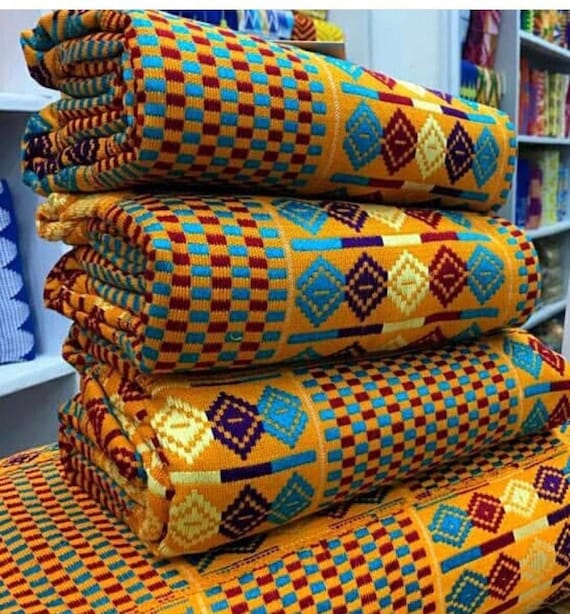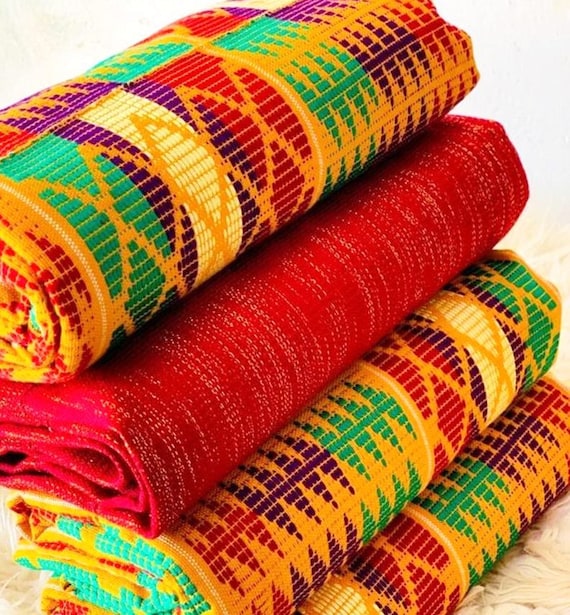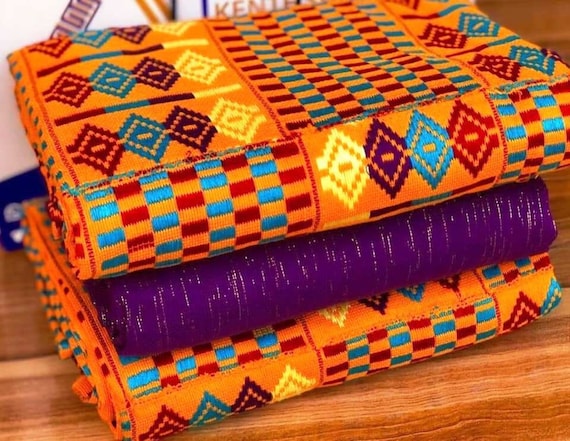Kente is one of Ghana's most important cultural symbols, representing the nation's rich heritage, history, and identity. Originating among the Ashanti people of the Akan ethnic group, kente is a handwoven cloth that carries significant cultural, spiritual, and social meaning. Over the years, it has become a national symbol for all Ghanaians, transcending ethnic boundaries.
Over the years, it has become a national symbol for all Ghanaians, transcending ethnic boundaries. In the vibrant cultural landscape of Ghana, the Kente cloth stands as a cherished emblem of tradition, craftsmanship, and profound cultural heritage. Woven with intricate patterns and vibrant hues, this iconic textile holds deep symbolism and historical significance, reflecting the pride, identity, and values of the Ghanaian people
Initially worn by royalty among the Ewe and Akans people in a toga- like fashion, Kente cloth has evolved into a symbol of celebrations and status, widely worn to commemorate special occasions in Ghana and other parts of West Africa such as Togo and Ivory Coast .
Asante oral tradition attributes the origins of Kente to and individual from Bonwire, who introduced the weaving loom to the Asante people from German during the reign of Nana Oti Akenten in the 17th century .
1. Origins and Historical Background
The origins of kente date back to the 17th century in the Ashanti Kingdom, which is now part of modern-day Ghana. According to legend, two Ashanti weavers learned the craft by observing a spider weaving its web. Inspired by the spider’s intricate designs, they developed the technique of weaving kente using local materials. Kente was exclusively worn by royalty and revered as a symbol of prestige and cultural heritage. Over time, this handwoven fabric gained global recognition, becoming an emblem of Ghanaian identity and a testament to the country’s rich artisticlegacies
Traditionally, kente was a royal cloth reserved for kings, queens, and other dignitaries. It was considered a symbol of high status and was worn during special occasions, ceremonies, and rituals. The cloth's association with royalty underscores its value and importance in Ghanaian culture.
2. Cultural Symbolism and Meaning
Colors: Each color used in kente weaving holds symbolic meaning:
Gold represents royalty, wealth, and spiritual purity.
Black signifies strength, maturity, and spiritual energy.
Green symbolizes growth, fertility, and health.
Red is associated with political and spiritual struggle, as well as sacrifice.
Blue stands for peace, harmony, and love.
Patterns and Motifs: Kente cloth patterns, or "Adweneasa" motifs, often carry specific meanings derived from Ghanaian proverbs, historical events, or cultural values. Some patterns honor significant people or commemorate important occasions. For example, the "Sika Dwa" (Golden Stool) pattern signifies the seat of Ashanti royalty, while "Fathia Fata Nkrumah" celebrates the marriage of Ghana's first president, Dr. Kwame Nkrumah, and his Egyptian wife, Fathia.
3. Traditional Uses and Social Significance
Rites of Passage and Ceremonies: Kente is worn during significant life events such as weddings, naming ceremonies, funerals, and festivals. It serves as a marker of social and cultural identity, connecting the wearer to their heritage.
Royal and Chieftaincy Events: During royal ceremonies, chiefs and members of the royal family don kente as a symbol of authority and tradition. Different designs or patterns may denote a chief's rank, lineage, or role.
National Celebrations and Festivities: Kente is prominently displayed during Ghanaian Independence Day celebrations, where it symbolizes national pride and cultural unity.
4. Evolution and Innovation; Modern Adaptations and Cultural Influence
While traditionally kente was woven from silk, contemporary versions often incorporate cotton and rayon, making the cloth more accessible to a wider audience. This shift has helped democratize kente, allowing Ghanaians from various backgrounds to wear it during both formal and casual events.Kente cloth remains deeply rooted in tradition, it also evolves with time. Contemporary adaptations include blending traditional designs with modern styles, catering to changing tastes and preferences while retaining the essence of its cultural significance.
it also evolves with time. Contemporary adaptations include blending traditional designs with modern styles, catering to changing tastes and preferences while retaining the essence of its cultural significance. Ghanaian designers and fashion brands have integrated kente into modern fashion, creating garments, accessories, and even home décor items. The cloth’s unique patterns are used to make jackets, dresses, ties, bags, and more.
The use of kente has expanded beyond Ghana, becoming a symbol of African heritage worldwide. In the African diaspora, kente is used to express cultural pride and identity, particularly during Black History Month and Pan-African events.
5. Economic Impact and Craft Preservation
Kente weaving is a source of livelihood for many artisans, particularly in traditional weaving towns like Bonwire, Adanwomase, and Agotime. These communities are known for producing authentic kente cloth using handloom techniques passed down through generations.
Efforts to preserve the traditional craft are ongoing, with initiatives to protect the intellectual property of kente designs and promote the use of authentic, locally-made kente. This helps sustain the craft and ensures the weavers’ skills are valued.
6. Ceremonial Attire, kente in cultural celebrations
Kente cloth holds a revered place in Ghanaian ceremonies and festivities. It is prominently worn during significant occasions such as weddings, funerals, and traditional rites of passage. The choice of Kente patterns and colors often signifies the importance of the event .
7. Social Significance; Expressing Identity and Heritage
Beyond its ceremonial role, Kente serves as a visual language, expressing the wearer’s identity, social status, and cultural heritage. In contemporary Ghanaian society, Kente cloth is not limited to royalty; it is embraced by people from all walks of life, serving as a symbol of national pride and unity.
8. Preservation and Global Impact
The art of Kente weaving has transcended local boundaries, garnering international acclaim and recognition. Its intricate beauty and cultural significance have captivated global audiences, with Kente cloth being worn and displayed at various events and ceremonies worldwide, symbolizing unity, diversity, and cultural appreciation.
9.Global Recognition and Symbolism meaning; stories in woven threads
Kente is recognized globally as a representation of Ghanaian and African heritage. It has been adopted in various forms, such as graduation stoles in universities across the world, to symbolize academic achievement and a connection to African roots.
The patterns and colors of Kente carry symbolic significance, often conveying messages related to values, ethics, and spirituality. For instance, the “Nsaa” pattern symbolizes excellence, with its depiction of stars reflecting the desire to strive for the highest aspirations. Other motifs such as “Duafe” (wooden comb) represent beauty and femininity, while “Dwennimmen” (ram’s horns) embodies strength and humility.
The cloth also serves as a powerful symbol in movements for social justice and Pan-Africanism. It embodies resilience, cultural pride, and the struggle for freedom and equality.
10. Craftsmanship and Symbolism
Kente cloth is meticulously handwoven using brightly colored silk or cotton threads. Its intricate patterns are not merely decorative but imbued with symbolism, with each design representing specific proverbs, historical events, or cultural beliefs. The intricate weaving technique incorporates geometric shapes and motifs, each carrying its own profound meaning within Ghanaian culture.
11. Cultural Heritage And Economic Empowerment
Kente weaving holds a vital place in Ghana’s cultural heritage and economic landscape. It serves as a source of livelihood for numerous artisans and weavers, preserving traditional craftsmanship while fostering economic empowerment within local communities.
12. Evolution And Innovation; Adapting Traditions
While Kente cloth remains deeply rooted in tradition, it also evolves with time. Contemporary adaptations include blending traditional designs with modern styles, catering to changing tastes and preferences while retaining the essence of its cultural significance.
Kente is more than just a textile; it is a cultural narrative woven into cloth, representing the stories, values, and history of Ghana. Its vibrant colors and patterns serve as a connection to the past, a celebration of the present, and a legacy for future generations.
 Over the years, it has become a national symbol for all Ghanaians, transcending ethnic boundaries.
Over the years, it has become a national symbol for all Ghanaians, transcending ethnic boundaries. it also evolves with time. Contemporary adaptations include blending traditional designs with modern styles, catering to changing tastes and preferences while retaining the essence of its cultural significance.
it also evolves with time. Contemporary adaptations include blending traditional designs with modern styles, catering to changing tastes and preferences while retaining the essence of its cultural significance.




